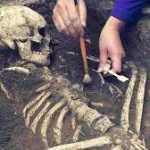Tennessee Man Films Giant Red UFOs Above a City Street0
- From Around the Web, UFO News
- August 15, 2022
They didn’t care who saw them.

They didn’t care who saw them.

The National Oceanic and Atmospheric Administration (NOAA) scientists were exploring the depths of the Atlantic Ocean floor when they somehow came across a strange line of holes that looked like humans had made it.

Using the most powerful space telescope ever built, astronomers spotted a galaxy that existed 13.4 billion years ago

NASA’s Perseverance rover captured an unusual image of something lying in the red sand of Mars: a bundle of string.

All of the Australopithecus-bearing cave sediments may be close to a million years older.

Google engineer Blake Lemoine caused a stir earlier this month when he claimed that the search giant’s LaMDA chatbot has gained sentience. Following his claims, Google put him on administrative leave for violating its confidentiality policy. Previously, a researcher at Google’s DeepMind AI division also hinted that they are on the verge of achieving human-level AI.

This behemoth has been powering an ultrabright quasar for 9 billion years.

Androids that are part human, part robot are a staple of science fiction. But they’re now a step closer to reality after researchers crafted a living skin for robots out of human cells.

The Curiosity rover has found an outstanding rock formation piercing the alien landscape of Mars. Amongst the shallow sands and boulders of the Gale Crater rise several twisting towers of rock – the spikes of sediment look almost like frozen streams of water poured from an invisible jug in the sky.

Neptune and Uranus are so similar that scientists sometimes refer to the distant, icy planets as planetary twins. But these ice giants have one big difference: their color.



